Organization and Behavior Report: Leadership, Motivation, and Teams
VerifiedAdded on 2020/06/04
|15
|4756
|54
Report
AI Summary
This report delves into the realm of organizational behavior, contrasting the structures and cultures of Toyota Motor Corporation and Ford Motor Company. It dissects the impacts of organizational structure and culture on project performance, alongside the factors influencing individual behavior within Toyota. The report then explores the effectiveness of various leadership styles, particularly autocratic and democratic approaches, and examines the application of organizational theory in management processes. It further investigates different management approaches, focusing on scientific management and human relations. The analysis extends to the effects of leadership styles on motivation, outlining motivational theories and their practical utility. Finally, the report examines group dynamics, factors promoting effective teamwork, and the influence of technology on team functioning, offering insights into enhancing organizational efficiency and employee engagement.
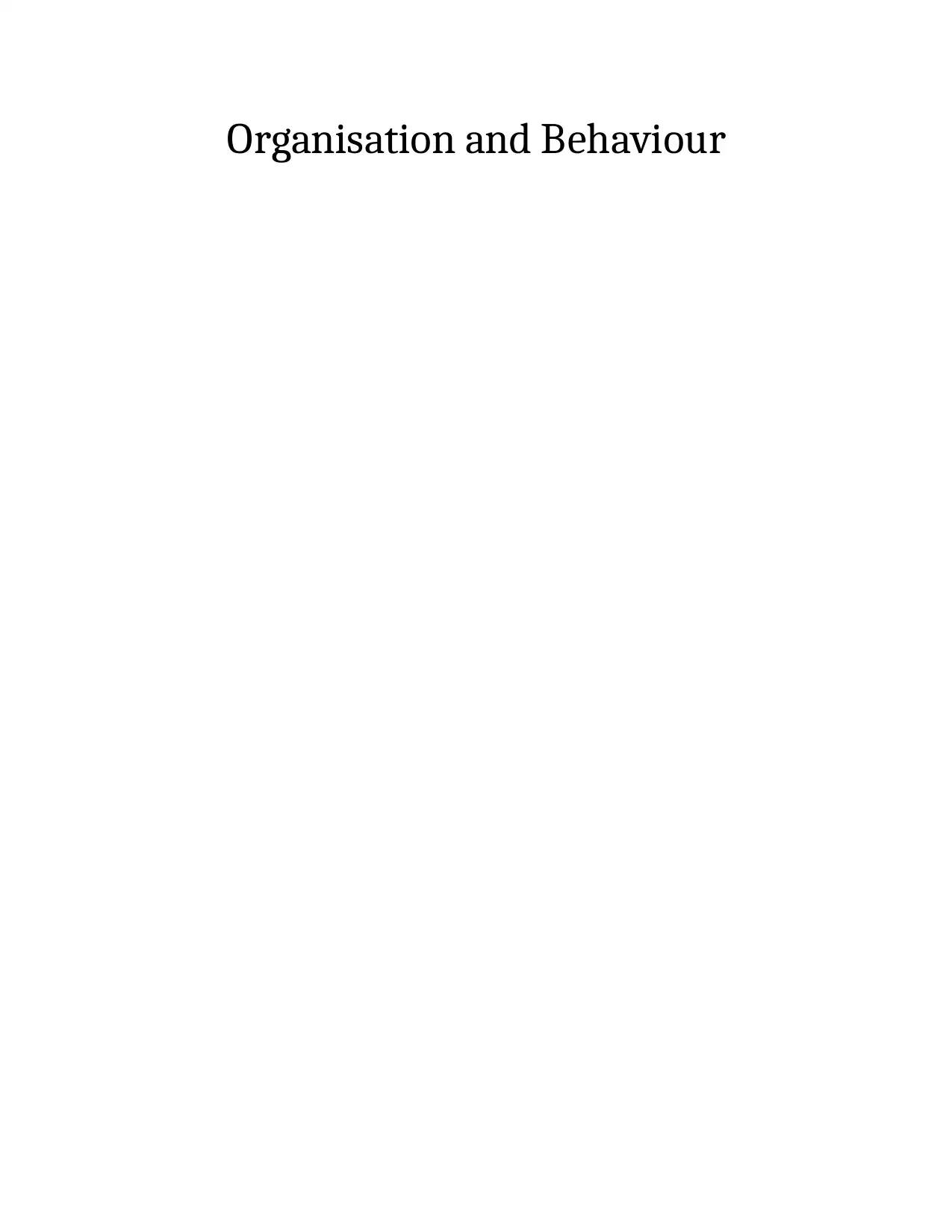
Organisation and Behaviour
Paraphrase This Document
Need a fresh take? Get an instant paraphrase of this document with our AI Paraphraser
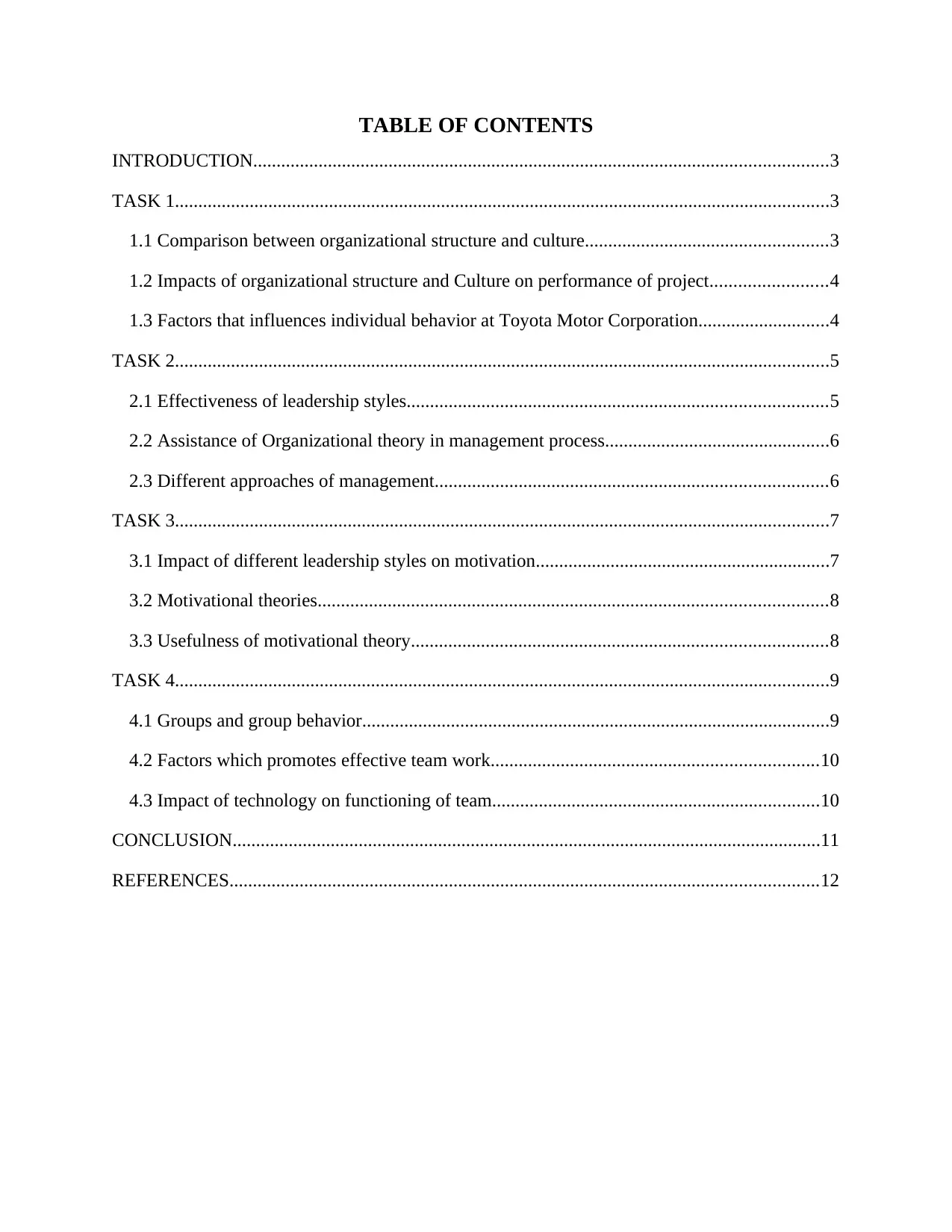
TABLE OF CONTENTS
INTRODUCTION...........................................................................................................................3
TASK 1............................................................................................................................................3
1.1 Comparison between organizational structure and culture....................................................3
1.2 Impacts of organizational structure and Culture on performance of project.........................4
1.3 Factors that influences individual behavior at Toyota Motor Corporation............................4
TASK 2............................................................................................................................................5
2.1 Effectiveness of leadership styles..........................................................................................5
2.2 Assistance of Organizational theory in management process................................................6
2.3 Different approaches of management....................................................................................6
TASK 3............................................................................................................................................7
3.1 Impact of different leadership styles on motivation...............................................................7
3.2 Motivational theories.............................................................................................................8
3.3 Usefulness of motivational theory.........................................................................................8
TASK 4............................................................................................................................................9
4.1 Groups and group behavior....................................................................................................9
4.2 Factors which promotes effective team work......................................................................10
4.3 Impact of technology on functioning of team......................................................................10
CONCLUSION..............................................................................................................................11
REFERENCES..............................................................................................................................12
INTRODUCTION...........................................................................................................................3
TASK 1............................................................................................................................................3
1.1 Comparison between organizational structure and culture....................................................3
1.2 Impacts of organizational structure and Culture on performance of project.........................4
1.3 Factors that influences individual behavior at Toyota Motor Corporation............................4
TASK 2............................................................................................................................................5
2.1 Effectiveness of leadership styles..........................................................................................5
2.2 Assistance of Organizational theory in management process................................................6
2.3 Different approaches of management....................................................................................6
TASK 3............................................................................................................................................7
3.1 Impact of different leadership styles on motivation...............................................................7
3.2 Motivational theories.............................................................................................................8
3.3 Usefulness of motivational theory.........................................................................................8
TASK 4............................................................................................................................................9
4.1 Groups and group behavior....................................................................................................9
4.2 Factors which promotes effective team work......................................................................10
4.3 Impact of technology on functioning of team......................................................................10
CONCLUSION..............................................................................................................................11
REFERENCES..............................................................................................................................12
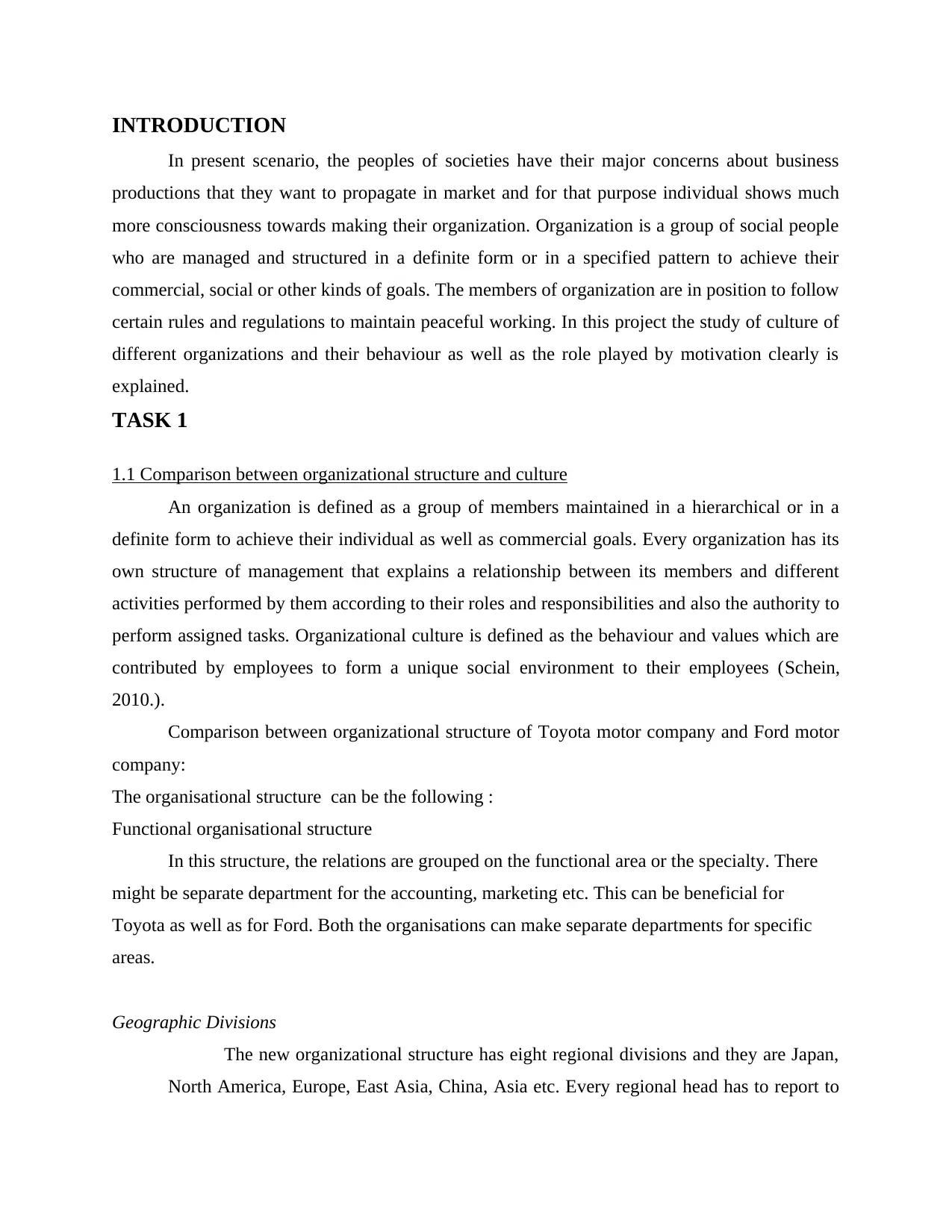
INTRODUCTION
In present scenario, the peoples of societies have their major concerns about business
productions that they want to propagate in market and for that purpose individual shows much
more consciousness towards making their organization. Organization is a group of social people
who are managed and structured in a definite form or in a specified pattern to achieve their
commercial, social or other kinds of goals. The members of organization are in position to follow
certain rules and regulations to maintain peaceful working. In this project the study of culture of
different organizations and their behaviour as well as the role played by motivation clearly is
explained.
TASK 1
1.1 Comparison between organizational structure and culture
An organization is defined as a group of members maintained in a hierarchical or in a
definite form to achieve their individual as well as commercial goals. Every organization has its
own structure of management that explains a relationship between its members and different
activities performed by them according to their roles and responsibilities and also the authority to
perform assigned tasks. Organizational culture is defined as the behaviour and values which are
contributed by employees to form a unique social environment to their employees (Schein,
2010.).
Comparison between organizational structure of Toyota motor company and Ford motor
company:
The organisational structure can be the following :
Functional organisational structure
In this structure, the relations are grouped on the functional area or the specialty. There
might be separate department for the accounting, marketing etc. This can be beneficial for
Toyota as well as for Ford. Both the organisations can make separate departments for specific
areas.
Geographic Divisions
The new organizational structure has eight regional divisions and they are Japan,
North America, Europe, East Asia, China, Asia etc. Every regional head has to report to
In present scenario, the peoples of societies have their major concerns about business
productions that they want to propagate in market and for that purpose individual shows much
more consciousness towards making their organization. Organization is a group of social people
who are managed and structured in a definite form or in a specified pattern to achieve their
commercial, social or other kinds of goals. The members of organization are in position to follow
certain rules and regulations to maintain peaceful working. In this project the study of culture of
different organizations and their behaviour as well as the role played by motivation clearly is
explained.
TASK 1
1.1 Comparison between organizational structure and culture
An organization is defined as a group of members maintained in a hierarchical or in a
definite form to achieve their individual as well as commercial goals. Every organization has its
own structure of management that explains a relationship between its members and different
activities performed by them according to their roles and responsibilities and also the authority to
perform assigned tasks. Organizational culture is defined as the behaviour and values which are
contributed by employees to form a unique social environment to their employees (Schein,
2010.).
Comparison between organizational structure of Toyota motor company and Ford motor
company:
The organisational structure can be the following :
Functional organisational structure
In this structure, the relations are grouped on the functional area or the specialty. There
might be separate department for the accounting, marketing etc. This can be beneficial for
Toyota as well as for Ford. Both the organisations can make separate departments for specific
areas.
Geographic Divisions
The new organizational structure has eight regional divisions and they are Japan,
North America, Europe, East Asia, China, Asia etc. Every regional head has to report to
⊘ This is a preview!⊘
Do you want full access?
Subscribe today to unlock all pages.

Trusted by 1+ million students worldwide
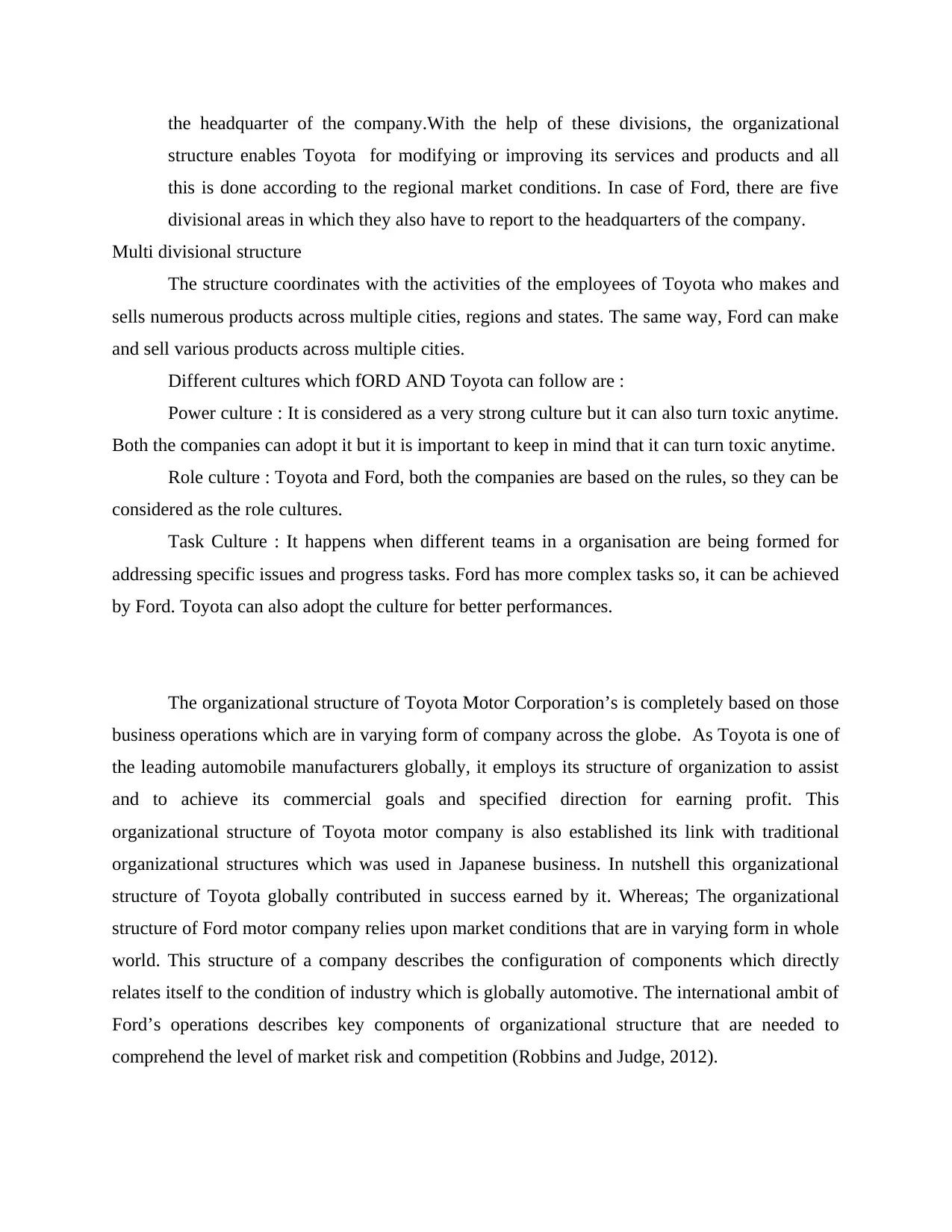
the headquarter of the company.With the help of these divisions, the organizational
structure enables Toyota for modifying or improving its services and products and all
this is done according to the regional market conditions. In case of Ford, there are five
divisional areas in which they also have to report to the headquarters of the company.
Multi divisional structure
The structure coordinates with the activities of the employees of Toyota who makes and
sells numerous products across multiple cities, regions and states. The same way, Ford can make
and sell various products across multiple cities.
Different cultures which fORD AND Toyota can follow are :
Power culture : It is considered as a very strong culture but it can also turn toxic anytime.
Both the companies can adopt it but it is important to keep in mind that it can turn toxic anytime.
Role culture : Toyota and Ford, both the companies are based on the rules, so they can be
considered as the role cultures.
Task Culture : It happens when different teams in a organisation are being formed for
addressing specific issues and progress tasks. Ford has more complex tasks so, it can be achieved
by Ford. Toyota can also adopt the culture for better performances.
The organizational structure of Toyota Motor Corporation’s is completely based on those
business operations which are in varying form of company across the globe. As Toyota is one of
the leading automobile manufacturers globally, it employs its structure of organization to assist
and to achieve its commercial goals and specified direction for earning profit. This
organizational structure of Toyota motor company is also established its link with traditional
organizational structures which was used in Japanese business. In nutshell this organizational
structure of Toyota globally contributed in success earned by it. Whereas; The organizational
structure of Ford motor company relies upon market conditions that are in varying form in whole
world. This structure of a company describes the configuration of components which directly
relates itself to the condition of industry which is globally automotive. The international ambit of
Ford’s operations describes key components of organizational structure that are needed to
comprehend the level of market risk and competition (Robbins and Judge, 2012).
structure enables Toyota for modifying or improving its services and products and all
this is done according to the regional market conditions. In case of Ford, there are five
divisional areas in which they also have to report to the headquarters of the company.
Multi divisional structure
The structure coordinates with the activities of the employees of Toyota who makes and
sells numerous products across multiple cities, regions and states. The same way, Ford can make
and sell various products across multiple cities.
Different cultures which fORD AND Toyota can follow are :
Power culture : It is considered as a very strong culture but it can also turn toxic anytime.
Both the companies can adopt it but it is important to keep in mind that it can turn toxic anytime.
Role culture : Toyota and Ford, both the companies are based on the rules, so they can be
considered as the role cultures.
Task Culture : It happens when different teams in a organisation are being formed for
addressing specific issues and progress tasks. Ford has more complex tasks so, it can be achieved
by Ford. Toyota can also adopt the culture for better performances.
The organizational structure of Toyota Motor Corporation’s is completely based on those
business operations which are in varying form of company across the globe. As Toyota is one of
the leading automobile manufacturers globally, it employs its structure of organization to assist
and to achieve its commercial goals and specified direction for earning profit. This
organizational structure of Toyota motor company is also established its link with traditional
organizational structures which was used in Japanese business. In nutshell this organizational
structure of Toyota globally contributed in success earned by it. Whereas; The organizational
structure of Ford motor company relies upon market conditions that are in varying form in whole
world. This structure of a company describes the configuration of components which directly
relates itself to the condition of industry which is globally automotive. The international ambit of
Ford’s operations describes key components of organizational structure that are needed to
comprehend the level of market risk and competition (Robbins and Judge, 2012).
Paraphrase This Document
Need a fresh take? Get an instant paraphrase of this document with our AI Paraphraser
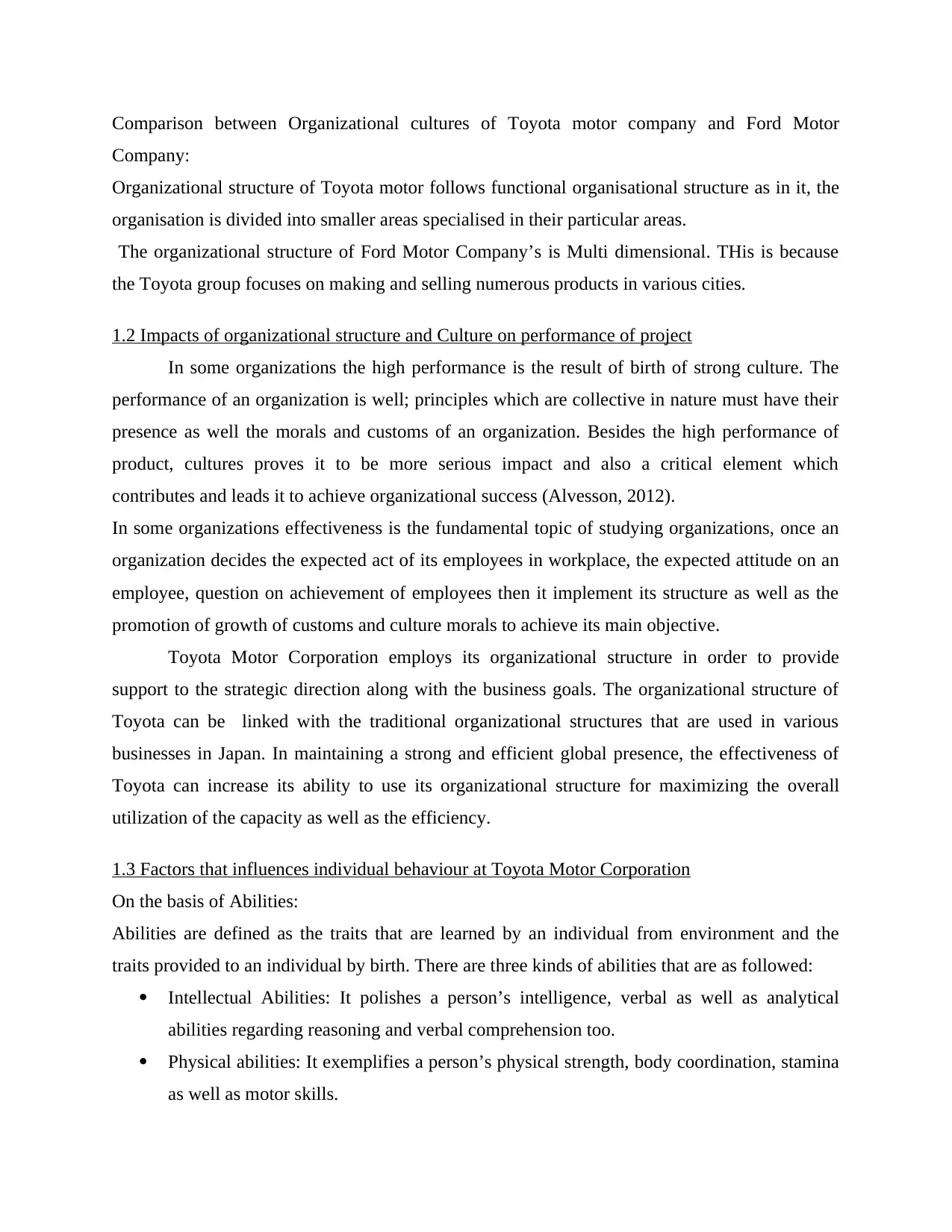
Comparison between Organizational cultures of Toyota motor company and Ford Motor
Company:
Organizational structure of Toyota motor follows functional organisational structure as in it, the
organisation is divided into smaller areas specialised in their particular areas.
The organizational structure of Ford Motor Company’s is Multi dimensional. THis is because
the Toyota group focuses on making and selling numerous products in various cities.
1.2 Impacts of organizational structure and Culture on performance of project
In some organizations the high performance is the result of birth of strong culture. The
performance of an organization is well; principles which are collective in nature must have their
presence as well the morals and customs of an organization. Besides the high performance of
product, cultures proves it to be more serious impact and also a critical element which
contributes and leads it to achieve organizational success (Alvesson, 2012).
In some organizations effectiveness is the fundamental topic of studying organizations, once an
organization decides the expected act of its employees in workplace, the expected attitude on an
employee, question on achievement of employees then it implement its structure as well as the
promotion of growth of customs and culture morals to achieve its main objective.
Toyota Motor Corporation employs its organizational structure in order to provide
support to the strategic direction along with the business goals. The organizational structure of
Toyota can be linked with the traditional organizational structures that are used in various
businesses in Japan. In maintaining a strong and efficient global presence, the effectiveness of
Toyota can increase its ability to use its organizational structure for maximizing the overall
utilization of the capacity as well as the efficiency.
1.3 Factors that influences individual behaviour at Toyota Motor Corporation
On the basis of Abilities:
Abilities are defined as the traits that are learned by an individual from environment and the
traits provided to an individual by birth. There are three kinds of abilities that are as followed:
Intellectual Abilities: It polishes a person’s intelligence, verbal as well as analytical
abilities regarding reasoning and verbal comprehension too.
Physical abilities: It exemplifies a person’s physical strength, body coordination, stamina
as well as motor skills.
Company:
Organizational structure of Toyota motor follows functional organisational structure as in it, the
organisation is divided into smaller areas specialised in their particular areas.
The organizational structure of Ford Motor Company’s is Multi dimensional. THis is because
the Toyota group focuses on making and selling numerous products in various cities.
1.2 Impacts of organizational structure and Culture on performance of project
In some organizations the high performance is the result of birth of strong culture. The
performance of an organization is well; principles which are collective in nature must have their
presence as well the morals and customs of an organization. Besides the high performance of
product, cultures proves it to be more serious impact and also a critical element which
contributes and leads it to achieve organizational success (Alvesson, 2012).
In some organizations effectiveness is the fundamental topic of studying organizations, once an
organization decides the expected act of its employees in workplace, the expected attitude on an
employee, question on achievement of employees then it implement its structure as well as the
promotion of growth of customs and culture morals to achieve its main objective.
Toyota Motor Corporation employs its organizational structure in order to provide
support to the strategic direction along with the business goals. The organizational structure of
Toyota can be linked with the traditional organizational structures that are used in various
businesses in Japan. In maintaining a strong and efficient global presence, the effectiveness of
Toyota can increase its ability to use its organizational structure for maximizing the overall
utilization of the capacity as well as the efficiency.
1.3 Factors that influences individual behaviour at Toyota Motor Corporation
On the basis of Abilities:
Abilities are defined as the traits that are learned by an individual from environment and the
traits provided to an individual by birth. There are three kinds of abilities that are as followed:
Intellectual Abilities: It polishes a person’s intelligence, verbal as well as analytical
abilities regarding reasoning and verbal comprehension too.
Physical abilities: It exemplifies a person’s physical strength, body coordination, stamina
as well as motor skills.
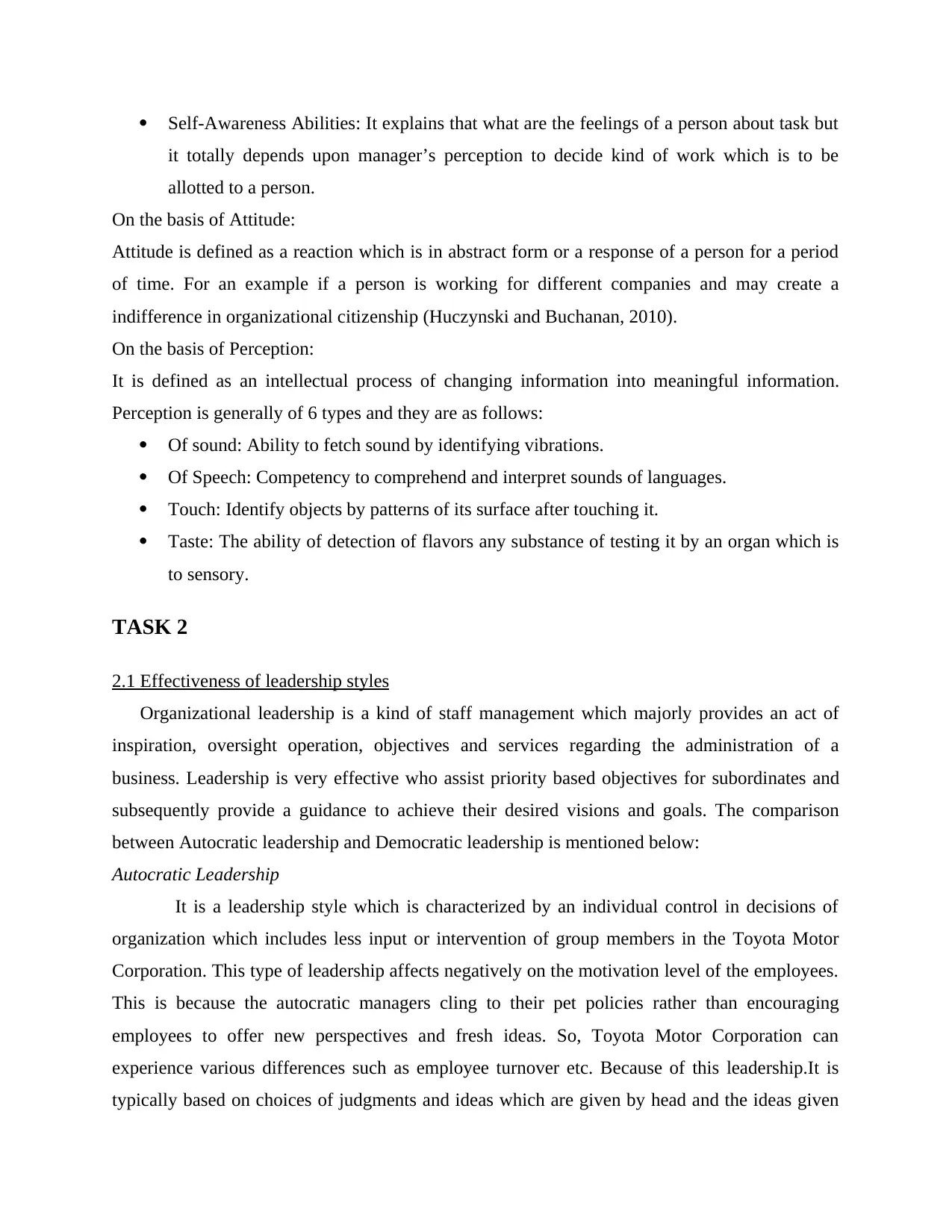
Self-Awareness Abilities: It explains that what are the feelings of a person about task but
it totally depends upon manager’s perception to decide kind of work which is to be
allotted to a person.
On the basis of Attitude:
Attitude is defined as a reaction which is in abstract form or a response of a person for a period
of time. For an example if a person is working for different companies and may create a
indifference in organizational citizenship (Huczynski and Buchanan, 2010).
On the basis of Perception:
It is defined as an intellectual process of changing information into meaningful information.
Perception is generally of 6 types and they are as follows:
Of sound: Ability to fetch sound by identifying vibrations.
Of Speech: Competency to comprehend and interpret sounds of languages.
Touch: Identify objects by patterns of its surface after touching it.
Taste: The ability of detection of flavors any substance of testing it by an organ which is
to sensory.
TASK 2
2.1 Effectiveness of leadership styles
Organizational leadership is a kind of staff management which majorly provides an act of
inspiration, oversight operation, objectives and services regarding the administration of a
business. Leadership is very effective who assist priority based objectives for subordinates and
subsequently provide a guidance to achieve their desired visions and goals. The comparison
between Autocratic leadership and Democratic leadership is mentioned below:
Autocratic Leadership
It is a leadership style which is characterized by an individual control in decisions of
organization which includes less input or intervention of group members in the Toyota Motor
Corporation. This type of leadership affects negatively on the motivation level of the employees.
This is because the autocratic managers cling to their pet policies rather than encouraging
employees to offer new perspectives and fresh ideas. So, Toyota Motor Corporation can
experience various differences such as employee turnover etc. Because of this leadership.It is
typically based on choices of judgments and ideas which are given by head and the ideas given
it totally depends upon manager’s perception to decide kind of work which is to be
allotted to a person.
On the basis of Attitude:
Attitude is defined as a reaction which is in abstract form or a response of a person for a period
of time. For an example if a person is working for different companies and may create a
indifference in organizational citizenship (Huczynski and Buchanan, 2010).
On the basis of Perception:
It is defined as an intellectual process of changing information into meaningful information.
Perception is generally of 6 types and they are as follows:
Of sound: Ability to fetch sound by identifying vibrations.
Of Speech: Competency to comprehend and interpret sounds of languages.
Touch: Identify objects by patterns of its surface after touching it.
Taste: The ability of detection of flavors any substance of testing it by an organ which is
to sensory.
TASK 2
2.1 Effectiveness of leadership styles
Organizational leadership is a kind of staff management which majorly provides an act of
inspiration, oversight operation, objectives and services regarding the administration of a
business. Leadership is very effective who assist priority based objectives for subordinates and
subsequently provide a guidance to achieve their desired visions and goals. The comparison
between Autocratic leadership and Democratic leadership is mentioned below:
Autocratic Leadership
It is a leadership style which is characterized by an individual control in decisions of
organization which includes less input or intervention of group members in the Toyota Motor
Corporation. This type of leadership affects negatively on the motivation level of the employees.
This is because the autocratic managers cling to their pet policies rather than encouraging
employees to offer new perspectives and fresh ideas. So, Toyota Motor Corporation can
experience various differences such as employee turnover etc. Because of this leadership.It is
typically based on choices of judgments and ideas which are given by head and the ideas given
⊘ This is a preview!⊘
Do you want full access?
Subscribe today to unlock all pages.

Trusted by 1+ million students worldwide
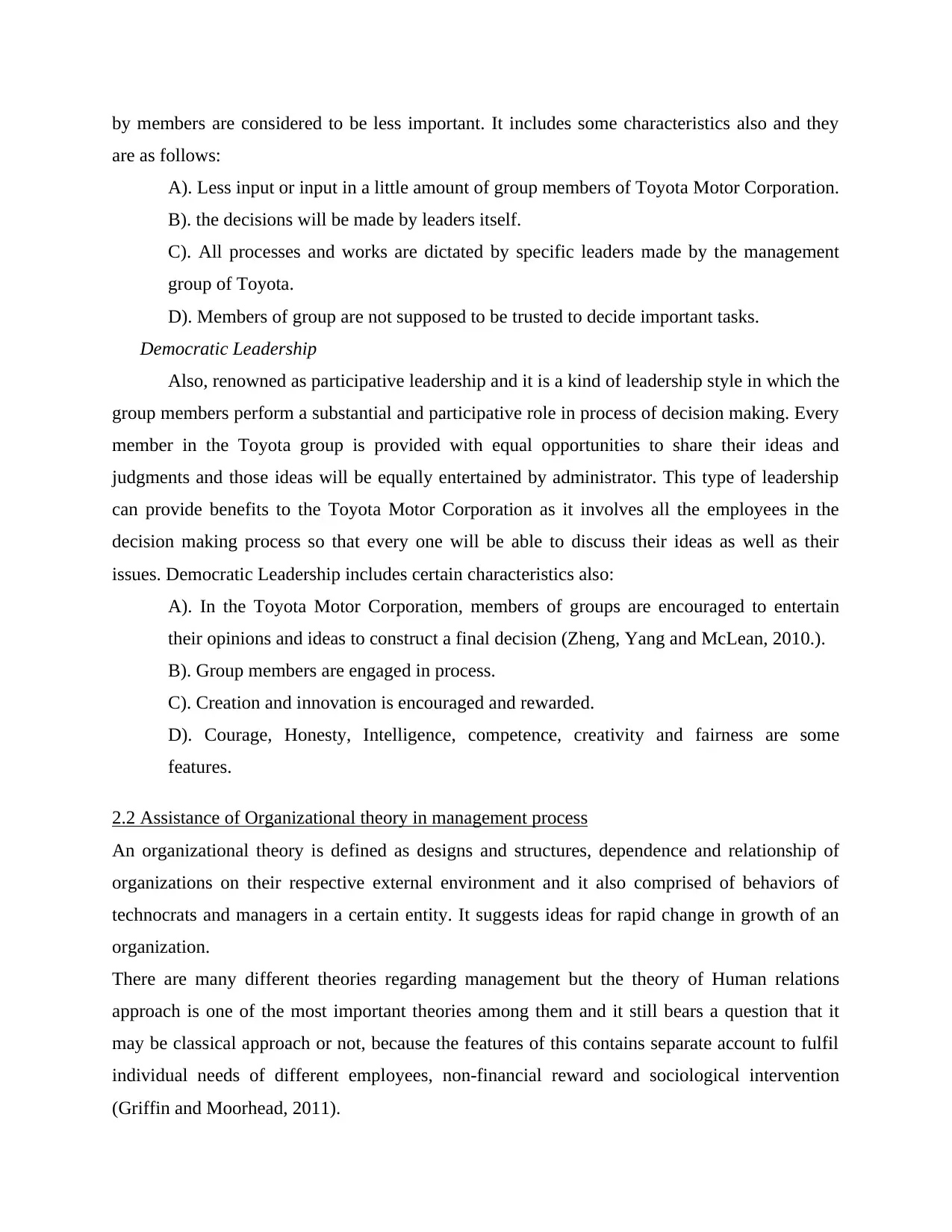
by members are considered to be less important. It includes some characteristics also and they
are as follows:
A). Less input or input in a little amount of group members of Toyota Motor Corporation.
B). the decisions will be made by leaders itself.
C). All processes and works are dictated by specific leaders made by the management
group of Toyota.
D). Members of group are not supposed to be trusted to decide important tasks.
Democratic Leadership
Also, renowned as participative leadership and it is a kind of leadership style in which the
group members perform a substantial and participative role in process of decision making. Every
member in the Toyota group is provided with equal opportunities to share their ideas and
judgments and those ideas will be equally entertained by administrator. This type of leadership
can provide benefits to the Toyota Motor Corporation as it involves all the employees in the
decision making process so that every one will be able to discuss their ideas as well as their
issues. Democratic Leadership includes certain characteristics also:
A). In the Toyota Motor Corporation, members of groups are encouraged to entertain
their opinions and ideas to construct a final decision (Zheng, Yang and McLean, 2010.).
B). Group members are engaged in process.
C). Creation and innovation is encouraged and rewarded.
D). Courage, Honesty, Intelligence, competence, creativity and fairness are some
features.
2.2 Assistance of Organizational theory in management process
An organizational theory is defined as designs and structures, dependence and relationship of
organizations on their respective external environment and it also comprised of behaviors of
technocrats and managers in a certain entity. It suggests ideas for rapid change in growth of an
organization.
There are many different theories regarding management but the theory of Human relations
approach is one of the most important theories among them and it still bears a question that it
may be classical approach or not, because the features of this contains separate account to fulfil
individual needs of different employees, non-financial reward and sociological intervention
(Griffin and Moorhead, 2011).
are as follows:
A). Less input or input in a little amount of group members of Toyota Motor Corporation.
B). the decisions will be made by leaders itself.
C). All processes and works are dictated by specific leaders made by the management
group of Toyota.
D). Members of group are not supposed to be trusted to decide important tasks.
Democratic Leadership
Also, renowned as participative leadership and it is a kind of leadership style in which the
group members perform a substantial and participative role in process of decision making. Every
member in the Toyota group is provided with equal opportunities to share their ideas and
judgments and those ideas will be equally entertained by administrator. This type of leadership
can provide benefits to the Toyota Motor Corporation as it involves all the employees in the
decision making process so that every one will be able to discuss their ideas as well as their
issues. Democratic Leadership includes certain characteristics also:
A). In the Toyota Motor Corporation, members of groups are encouraged to entertain
their opinions and ideas to construct a final decision (Zheng, Yang and McLean, 2010.).
B). Group members are engaged in process.
C). Creation and innovation is encouraged and rewarded.
D). Courage, Honesty, Intelligence, competence, creativity and fairness are some
features.
2.2 Assistance of Organizational theory in management process
An organizational theory is defined as designs and structures, dependence and relationship of
organizations on their respective external environment and it also comprised of behaviors of
technocrats and managers in a certain entity. It suggests ideas for rapid change in growth of an
organization.
There are many different theories regarding management but the theory of Human relations
approach is one of the most important theories among them and it still bears a question that it
may be classical approach or not, because the features of this contains separate account to fulfil
individual needs of different employees, non-financial reward and sociological intervention
(Griffin and Moorhead, 2011).
Paraphrase This Document
Need a fresh take? Get an instant paraphrase of this document with our AI Paraphraser
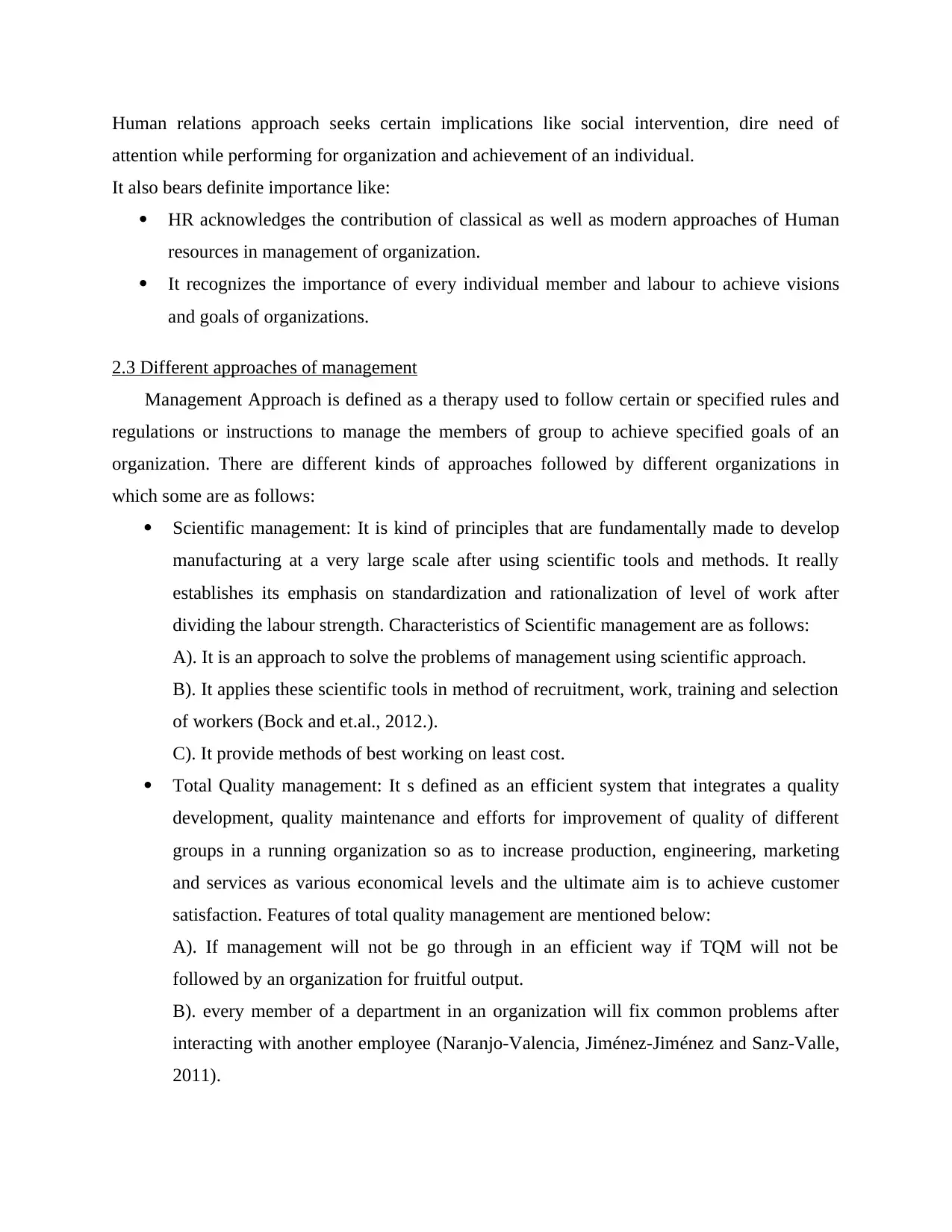
Human relations approach seeks certain implications like social intervention, dire need of
attention while performing for organization and achievement of an individual.
It also bears definite importance like:
HR acknowledges the contribution of classical as well as modern approaches of Human
resources in management of organization.
It recognizes the importance of every individual member and labour to achieve visions
and goals of organizations.
2.3 Different approaches of management
Management Approach is defined as a therapy used to follow certain or specified rules and
regulations or instructions to manage the members of group to achieve specified goals of an
organization. There are different kinds of approaches followed by different organizations in
which some are as follows:
Scientific management: It is kind of principles that are fundamentally made to develop
manufacturing at a very large scale after using scientific tools and methods. It really
establishes its emphasis on standardization and rationalization of level of work after
dividing the labour strength. Characteristics of Scientific management are as follows:
A). It is an approach to solve the problems of management using scientific approach.
B). It applies these scientific tools in method of recruitment, work, training and selection
of workers (Bock and et.al., 2012.).
C). It provide methods of best working on least cost.
Total Quality management: It s defined as an efficient system that integrates a quality
development, quality maintenance and efforts for improvement of quality of different
groups in a running organization so as to increase production, engineering, marketing
and services as various economical levels and the ultimate aim is to achieve customer
satisfaction. Features of total quality management are mentioned below:
A). If management will not be go through in an efficient way if TQM will not be
followed by an organization for fruitful output.
B). every member of a department in an organization will fix common problems after
interacting with another employee (Naranjo-Valencia, Jiménez-Jiménez and Sanz-Valle,
2011).
attention while performing for organization and achievement of an individual.
It also bears definite importance like:
HR acknowledges the contribution of classical as well as modern approaches of Human
resources in management of organization.
It recognizes the importance of every individual member and labour to achieve visions
and goals of organizations.
2.3 Different approaches of management
Management Approach is defined as a therapy used to follow certain or specified rules and
regulations or instructions to manage the members of group to achieve specified goals of an
organization. There are different kinds of approaches followed by different organizations in
which some are as follows:
Scientific management: It is kind of principles that are fundamentally made to develop
manufacturing at a very large scale after using scientific tools and methods. It really
establishes its emphasis on standardization and rationalization of level of work after
dividing the labour strength. Characteristics of Scientific management are as follows:
A). It is an approach to solve the problems of management using scientific approach.
B). It applies these scientific tools in method of recruitment, work, training and selection
of workers (Bock and et.al., 2012.).
C). It provide methods of best working on least cost.
Total Quality management: It s defined as an efficient system that integrates a quality
development, quality maintenance and efforts for improvement of quality of different
groups in a running organization so as to increase production, engineering, marketing
and services as various economical levels and the ultimate aim is to achieve customer
satisfaction. Features of total quality management are mentioned below:
A). If management will not be go through in an efficient way if TQM will not be
followed by an organization for fruitful output.
B). every member of a department in an organization will fix common problems after
interacting with another employee (Naranjo-Valencia, Jiménez-Jiménez and Sanz-Valle,
2011).
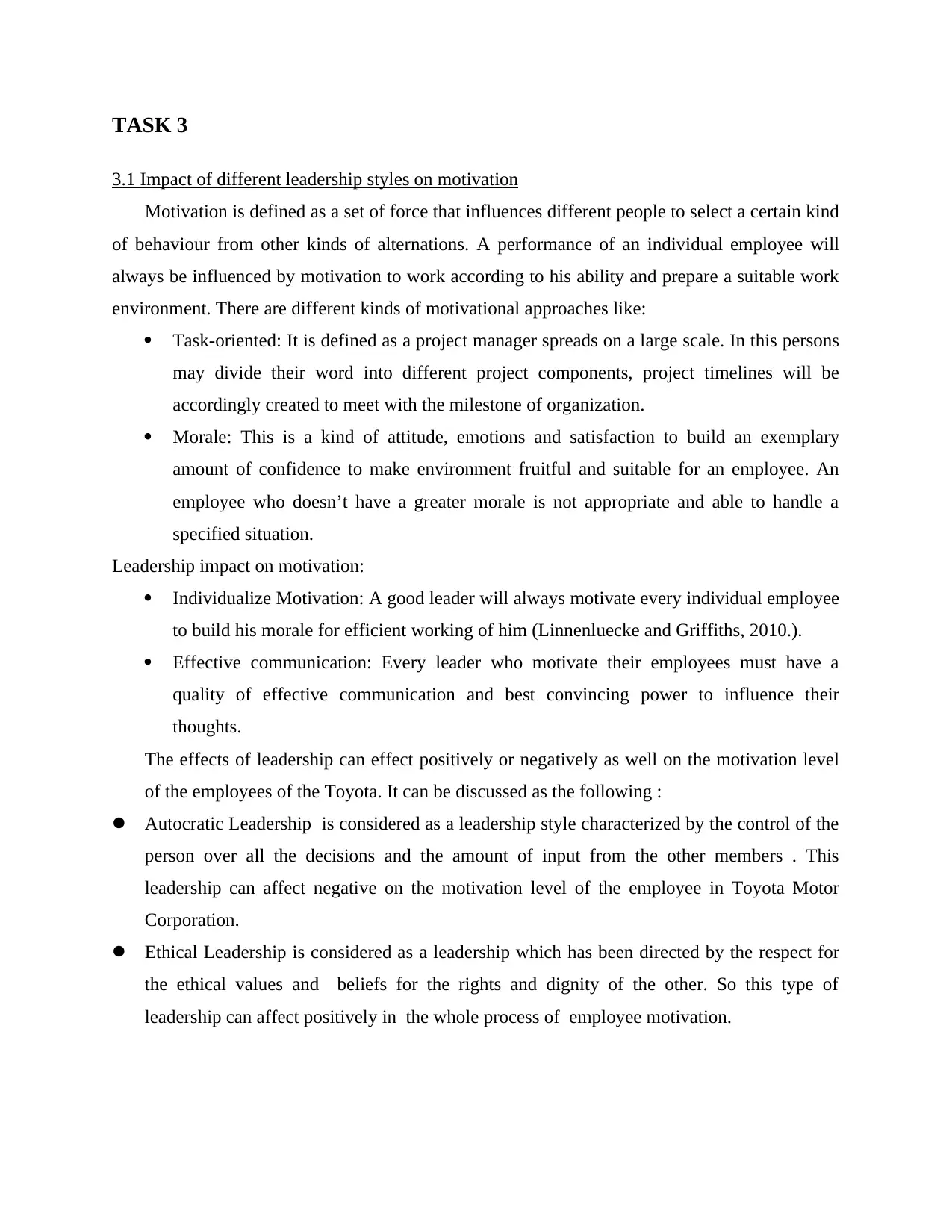
TASK 3
3.1 Impact of different leadership styles on motivation
Motivation is defined as a set of force that influences different people to select a certain kind
of behaviour from other kinds of alternations. A performance of an individual employee will
always be influenced by motivation to work according to his ability and prepare a suitable work
environment. There are different kinds of motivational approaches like:
Task-oriented: It is defined as a project manager spreads on a large scale. In this persons
may divide their word into different project components, project timelines will be
accordingly created to meet with the milestone of organization.
Morale: This is a kind of attitude, emotions and satisfaction to build an exemplary
amount of confidence to make environment fruitful and suitable for an employee. An
employee who doesn’t have a greater morale is not appropriate and able to handle a
specified situation.
Leadership impact on motivation:
Individualize Motivation: A good leader will always motivate every individual employee
to build his morale for efficient working of him (Linnenluecke and Griffiths, 2010.).
Effective communication: Every leader who motivate their employees must have a
quality of effective communication and best convincing power to influence their
thoughts.
The effects of leadership can effect positively or negatively as well on the motivation level
of the employees of the Toyota. It can be discussed as the following :
Autocratic Leadership is considered as a leadership style characterized by the control of the
person over all the decisions and the amount of input from the other members . This
leadership can affect negative on the motivation level of the employee in Toyota Motor
Corporation.
Ethical Leadership is considered as a leadership which has been directed by the respect for
the ethical values and beliefs for the rights and dignity of the other. So this type of
leadership can affect positively in the whole process of employee motivation.
3.1 Impact of different leadership styles on motivation
Motivation is defined as a set of force that influences different people to select a certain kind
of behaviour from other kinds of alternations. A performance of an individual employee will
always be influenced by motivation to work according to his ability and prepare a suitable work
environment. There are different kinds of motivational approaches like:
Task-oriented: It is defined as a project manager spreads on a large scale. In this persons
may divide their word into different project components, project timelines will be
accordingly created to meet with the milestone of organization.
Morale: This is a kind of attitude, emotions and satisfaction to build an exemplary
amount of confidence to make environment fruitful and suitable for an employee. An
employee who doesn’t have a greater morale is not appropriate and able to handle a
specified situation.
Leadership impact on motivation:
Individualize Motivation: A good leader will always motivate every individual employee
to build his morale for efficient working of him (Linnenluecke and Griffiths, 2010.).
Effective communication: Every leader who motivate their employees must have a
quality of effective communication and best convincing power to influence their
thoughts.
The effects of leadership can effect positively or negatively as well on the motivation level
of the employees of the Toyota. It can be discussed as the following :
Autocratic Leadership is considered as a leadership style characterized by the control of the
person over all the decisions and the amount of input from the other members . This
leadership can affect negative on the motivation level of the employee in Toyota Motor
Corporation.
Ethical Leadership is considered as a leadership which has been directed by the respect for
the ethical values and beliefs for the rights and dignity of the other. So this type of
leadership can affect positively in the whole process of employee motivation.
⊘ This is a preview!⊘
Do you want full access?
Subscribe today to unlock all pages.

Trusted by 1+ million students worldwide
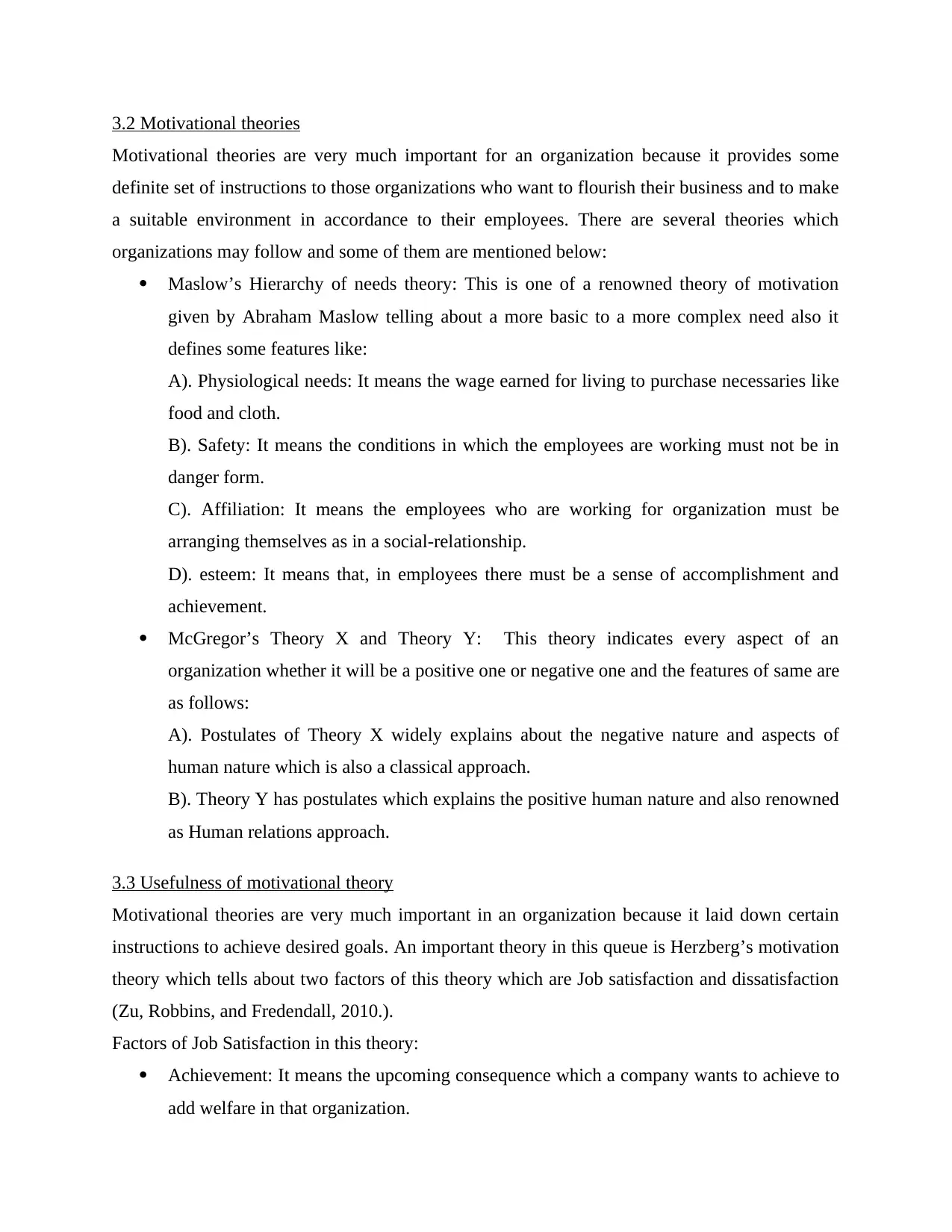
3.2 Motivational theories
Motivational theories are very much important for an organization because it provides some
definite set of instructions to those organizations who want to flourish their business and to make
a suitable environment in accordance to their employees. There are several theories which
organizations may follow and some of them are mentioned below:
Maslow’s Hierarchy of needs theory: This is one of a renowned theory of motivation
given by Abraham Maslow telling about a more basic to a more complex need also it
defines some features like:
A). Physiological needs: It means the wage earned for living to purchase necessaries like
food and cloth.
B). Safety: It means the conditions in which the employees are working must not be in
danger form.
C). Affiliation: It means the employees who are working for organization must be
arranging themselves as in a social-relationship.
D). esteem: It means that, in employees there must be a sense of accomplishment and
achievement.
McGregor’s Theory X and Theory Y: This theory indicates every aspect of an
organization whether it will be a positive one or negative one and the features of same are
as follows:
A). Postulates of Theory X widely explains about the negative nature and aspects of
human nature which is also a classical approach.
B). Theory Y has postulates which explains the positive human nature and also renowned
as Human relations approach.
3.3 Usefulness of motivational theory
Motivational theories are very much important in an organization because it laid down certain
instructions to achieve desired goals. An important theory in this queue is Herzberg’s motivation
theory which tells about two factors of this theory which are Job satisfaction and dissatisfaction
(Zu, Robbins, and Fredendall, 2010.).
Factors of Job Satisfaction in this theory:
Achievement: It means the upcoming consequence which a company wants to achieve to
add welfare in that organization.
Motivational theories are very much important for an organization because it provides some
definite set of instructions to those organizations who want to flourish their business and to make
a suitable environment in accordance to their employees. There are several theories which
organizations may follow and some of them are mentioned below:
Maslow’s Hierarchy of needs theory: This is one of a renowned theory of motivation
given by Abraham Maslow telling about a more basic to a more complex need also it
defines some features like:
A). Physiological needs: It means the wage earned for living to purchase necessaries like
food and cloth.
B). Safety: It means the conditions in which the employees are working must not be in
danger form.
C). Affiliation: It means the employees who are working for organization must be
arranging themselves as in a social-relationship.
D). esteem: It means that, in employees there must be a sense of accomplishment and
achievement.
McGregor’s Theory X and Theory Y: This theory indicates every aspect of an
organization whether it will be a positive one or negative one and the features of same are
as follows:
A). Postulates of Theory X widely explains about the negative nature and aspects of
human nature which is also a classical approach.
B). Theory Y has postulates which explains the positive human nature and also renowned
as Human relations approach.
3.3 Usefulness of motivational theory
Motivational theories are very much important in an organization because it laid down certain
instructions to achieve desired goals. An important theory in this queue is Herzberg’s motivation
theory which tells about two factors of this theory which are Job satisfaction and dissatisfaction
(Zu, Robbins, and Fredendall, 2010.).
Factors of Job Satisfaction in this theory:
Achievement: It means the upcoming consequence which a company wants to achieve to
add welfare in that organization.
Paraphrase This Document
Need a fresh take? Get an instant paraphrase of this document with our AI Paraphraser
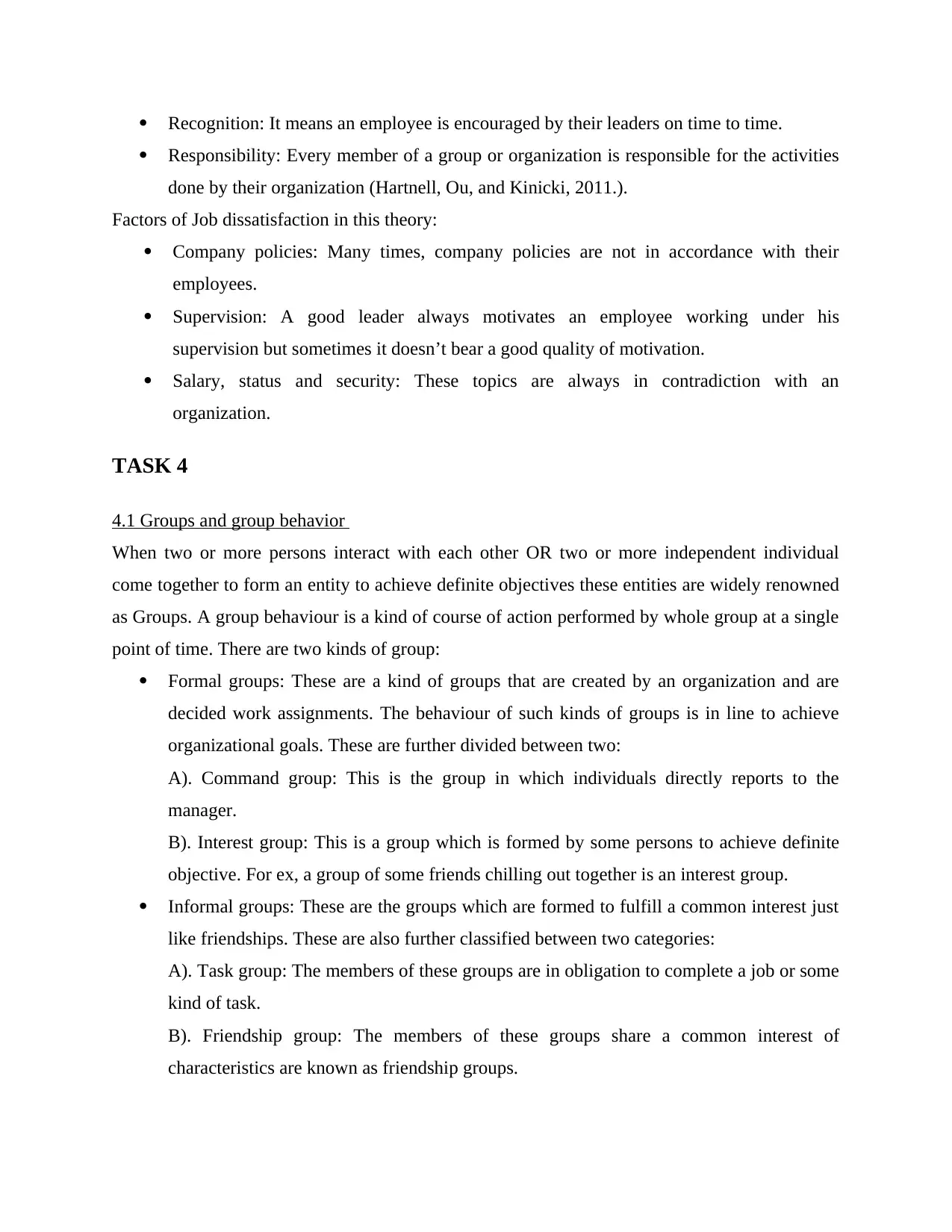
Recognition: It means an employee is encouraged by their leaders on time to time.
Responsibility: Every member of a group or organization is responsible for the activities
done by their organization (Hartnell, Ou, and Kinicki, 2011.).
Factors of Job dissatisfaction in this theory:
Company policies: Many times, company policies are not in accordance with their
employees.
Supervision: A good leader always motivates an employee working under his
supervision but sometimes it doesn’t bear a good quality of motivation.
Salary, status and security: These topics are always in contradiction with an
organization.
TASK 4
4.1 Groups and group behavior
When two or more persons interact with each other OR two or more independent individual
come together to form an entity to achieve definite objectives these entities are widely renowned
as Groups. A group behaviour is a kind of course of action performed by whole group at a single
point of time. There are two kinds of group:
Formal groups: These are a kind of groups that are created by an organization and are
decided work assignments. The behaviour of such kinds of groups is in line to achieve
organizational goals. These are further divided between two:
A). Command group: This is the group in which individuals directly reports to the
manager.
B). Interest group: This is a group which is formed by some persons to achieve definite
objective. For ex, a group of some friends chilling out together is an interest group.
Informal groups: These are the groups which are formed to fulfill a common interest just
like friendships. These are also further classified between two categories:
A). Task group: The members of these groups are in obligation to complete a job or some
kind of task.
B). Friendship group: The members of these groups share a common interest of
characteristics are known as friendship groups.
Responsibility: Every member of a group or organization is responsible for the activities
done by their organization (Hartnell, Ou, and Kinicki, 2011.).
Factors of Job dissatisfaction in this theory:
Company policies: Many times, company policies are not in accordance with their
employees.
Supervision: A good leader always motivates an employee working under his
supervision but sometimes it doesn’t bear a good quality of motivation.
Salary, status and security: These topics are always in contradiction with an
organization.
TASK 4
4.1 Groups and group behavior
When two or more persons interact with each other OR two or more independent individual
come together to form an entity to achieve definite objectives these entities are widely renowned
as Groups. A group behaviour is a kind of course of action performed by whole group at a single
point of time. There are two kinds of group:
Formal groups: These are a kind of groups that are created by an organization and are
decided work assignments. The behaviour of such kinds of groups is in line to achieve
organizational goals. These are further divided between two:
A). Command group: This is the group in which individuals directly reports to the
manager.
B). Interest group: This is a group which is formed by some persons to achieve definite
objective. For ex, a group of some friends chilling out together is an interest group.
Informal groups: These are the groups which are formed to fulfill a common interest just
like friendships. These are also further classified between two categories:
A). Task group: The members of these groups are in obligation to complete a job or some
kind of task.
B). Friendship group: The members of these groups share a common interest of
characteristics are known as friendship groups.
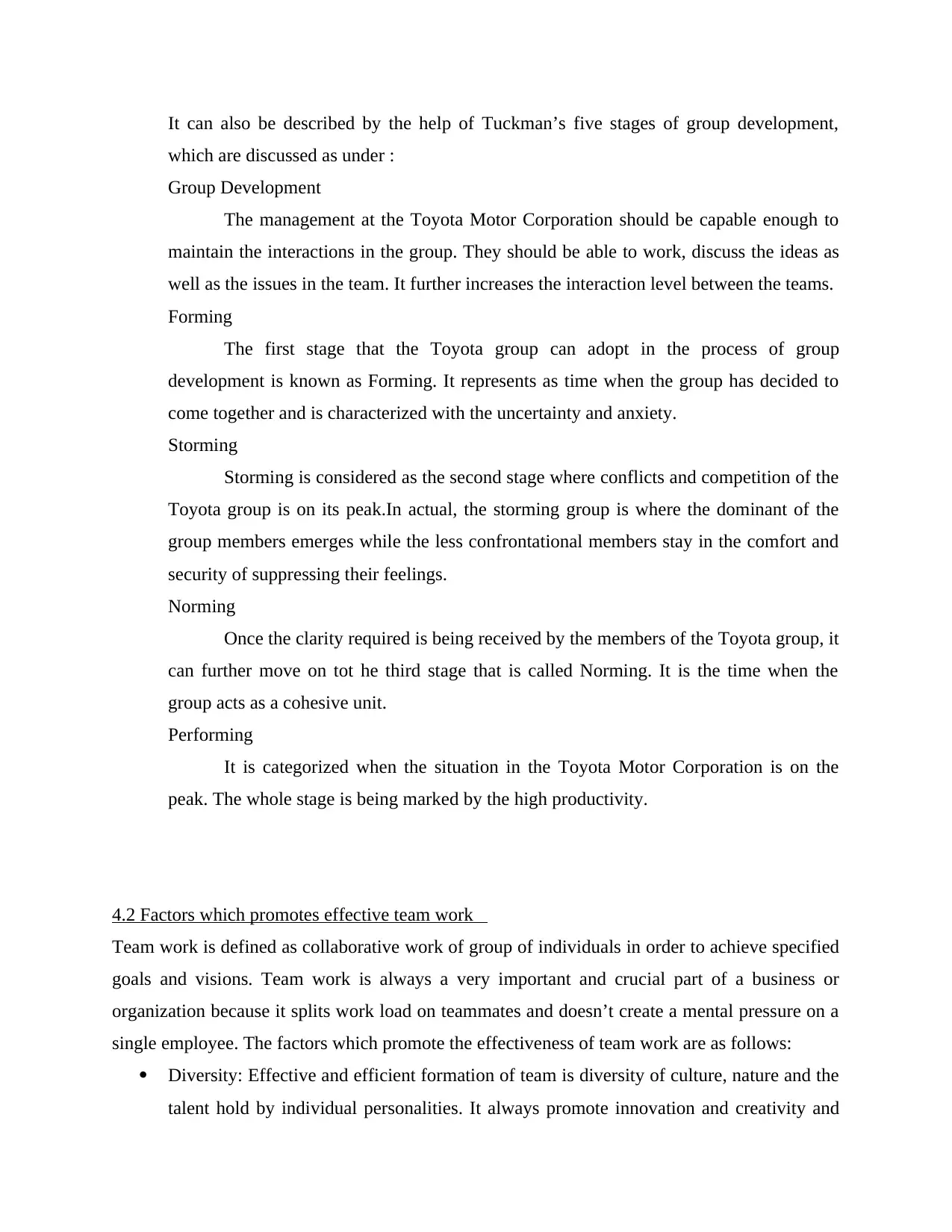
It can also be described by the help of Tuckman’s five stages of group development,
which are discussed as under :
Group Development
The management at the Toyota Motor Corporation should be capable enough to
maintain the interactions in the group. They should be able to work, discuss the ideas as
well as the issues in the team. It further increases the interaction level between the teams.
Forming
The first stage that the Toyota group can adopt in the process of group
development is known as Forming. It represents as time when the group has decided to
come together and is characterized with the uncertainty and anxiety.
Storming
Storming is considered as the second stage where conflicts and competition of the
Toyota group is on its peak.In actual, the storming group is where the dominant of the
group members emerges while the less confrontational members stay in the comfort and
security of suppressing their feelings.
Norming
Once the clarity required is being received by the members of the Toyota group, it
can further move on tot he third stage that is called Norming. It is the time when the
group acts as a cohesive unit.
Performing
It is categorized when the situation in the Toyota Motor Corporation is on the
peak. The whole stage is being marked by the high productivity.
4.2 Factors which promotes effective team work
Team work is defined as collaborative work of group of individuals in order to achieve specified
goals and visions. Team work is always a very important and crucial part of a business or
organization because it splits work load on teammates and doesn’t create a mental pressure on a
single employee. The factors which promote the effectiveness of team work are as follows:
Diversity: Effective and efficient formation of team is diversity of culture, nature and the
talent hold by individual personalities. It always promote innovation and creativity and
which are discussed as under :
Group Development
The management at the Toyota Motor Corporation should be capable enough to
maintain the interactions in the group. They should be able to work, discuss the ideas as
well as the issues in the team. It further increases the interaction level between the teams.
Forming
The first stage that the Toyota group can adopt in the process of group
development is known as Forming. It represents as time when the group has decided to
come together and is characterized with the uncertainty and anxiety.
Storming
Storming is considered as the second stage where conflicts and competition of the
Toyota group is on its peak.In actual, the storming group is where the dominant of the
group members emerges while the less confrontational members stay in the comfort and
security of suppressing their feelings.
Norming
Once the clarity required is being received by the members of the Toyota group, it
can further move on tot he third stage that is called Norming. It is the time when the
group acts as a cohesive unit.
Performing
It is categorized when the situation in the Toyota Motor Corporation is on the
peak. The whole stage is being marked by the high productivity.
4.2 Factors which promotes effective team work
Team work is defined as collaborative work of group of individuals in order to achieve specified
goals and visions. Team work is always a very important and crucial part of a business or
organization because it splits work load on teammates and doesn’t create a mental pressure on a
single employee. The factors which promote the effectiveness of team work are as follows:
Diversity: Effective and efficient formation of team is diversity of culture, nature and the
talent hold by individual personalities. It always promote innovation and creativity and
⊘ This is a preview!⊘
Do you want full access?
Subscribe today to unlock all pages.

Trusted by 1+ million students worldwide
1 out of 15
Related Documents
Your All-in-One AI-Powered Toolkit for Academic Success.
+13062052269
info@desklib.com
Available 24*7 on WhatsApp / Email
![[object Object]](/_next/static/media/star-bottom.7253800d.svg)
Unlock your academic potential
Copyright © 2020–2025 A2Z Services. All Rights Reserved. Developed and managed by ZUCOL.




